
|
Features
|
|
|
|
Books
|
|
|
|
Fun & Games
|
|
|
|
Contact Us
|
|
|
Night Hawk Stories... Entry 33
The Caribou Mystique
by John E.
Phillips
Page 1
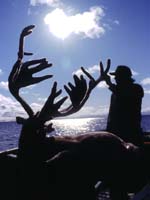 You
can hunt many species of big game with black powder including sheep, goat,
ram, moose, antelope, caribou, bear and boar. But my most memorable black-powder
hunt ever took place in the Far North.
You
can hunt many species of big game with black powder including sheep, goat,
ram, moose, antelope, caribou, bear and boar. But my most memorable black-powder
hunt ever took place in the Far North.
The Inuit people and the caribou near Ungava Bay, Canada, which means, "the end of the world," have had to practice their survival skills extensively. For thousands of years, they have existed in much the same way as they do today. As years have passed and seasons have changed, the caribou and the Inuit have followed much the same routes and traditions as they have since the beginning of time.
"One day I'll hunt the great bear with a lance as my forefathers did," my guide Paulossie "Paul" Napartuk, an Inuit Eskimo, told me as I looked across the gray land for caribou. "I'll turn my dogs loose on the bear. When the dogs have the polar bear's attention, I'll attack the bear and take him with my lance. Whether he hurts me or kills me doesn't matter. I will have followed the tradition of my people, and I will have proved I'm a man."
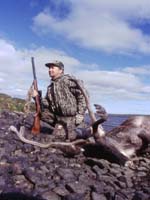 Napartuk,
a young man of this bleak, treeless, barren ground of rocks, moss, snow,
ice, polar bears, caribou, lake trout and arctic char, tells everyone
how much he values his heritage. "Before long, I plan to spend a year
on my own living off the land as my ancestors once did. I want to know
I can survive today as they did."
Napartuk,
a young man of this bleak, treeless, barren ground of rocks, moss, snow,
ice, polar bears, caribou, lake trout and arctic char, tells everyone
how much he values his heritage. "Before long, I plan to spend a year
on my own living off the land as my ancestors once did. I want to know
I can survive today as they did."
I met Napartuk, a guide for Silak Adventures, Incorporated, in Quebec, Canada, on a caribou hunt on the shores of Lake Ballantyne, North of the 57th parallel and 300-miles south of the Arctic Circle. Today these people, who have lived for generations in this land with its sub-arctic climate, administer their native-controlled lands in Northernmost Quebec for the hunting and fishing rights.
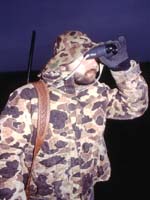 To
reach Lake Ballantyne, the location of our base camp, we had to fly by
float plane for 35-minutes from Kuujjuaq (Fort Chimo), about 1,000 miles
north of Montreal. My hunting companions, Tony Zappia from Messina, New
York, and two of his friends, Steve and Bruce Anderson from Traverse City,
Michigan, accompanied me on my mission to take a caribou with my black-powder
Connecticut Valley Arms (CVA) St. Louis Hawken rifle.
To
reach Lake Ballantyne, the location of our base camp, we had to fly by
float plane for 35-minutes from Kuujjuaq (Fort Chimo), about 1,000 miles
north of Montreal. My hunting companions, Tony Zappia from Messina, New
York, and two of his friends, Steve and Bruce Anderson from Traverse City,
Michigan, accompanied me on my mission to take a caribou with my black-powder
Connecticut Valley Arms (CVA) St. Louis Hawken rifle.
The first morning we hunted this area I wondered how we could stalk the caribou of the Ungava Bay herd, which numbered about 750,000 animals, when not even a blade of grass stood on the face of this earth. We planned to hunt during the annual caribou migration where 5,000 to 6,000 animals would pass through the region of the camp per day. But although we saw caribou in the distance, we never got closer than a half-mile of the animals.
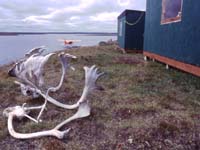 However,
on the second day of the hunt, our luck changed for the better and the
worse. Zappia carried my 7mm rifle, and I had my CVA Hawken. If the caribou
came close, I would take the first shot with my black-powder gun. If we
saw the animals at a distance, Zappia would try and down one with the
more modern weapon.
However,
on the second day of the hunt, our luck changed for the better and the
worse. Zappia carried my 7mm rifle, and I had my CVA Hawken. If the caribou
came close, I would take the first shot with my black-powder gun. If we
saw the animals at a distance, Zappia would try and down one with the
more modern weapon.
About 9:00 a.m., Zappia, Napartuk, the Anderson brothers and I beached our motor-powered canoe on the shore of one of the hundreds of crystal-clear lakes near camp. Carrying only our rifles, we walked to the top of a ridge to search for caribou. When we spotted a big bull, Zappia, Napartuk and I took off at a sprinter's pace to get close enough to take a shot. The chase for the big bull lasted about four miles. We stopped frequently to look for the caribou in the rolling terrain and to catch our breath. Then we could steady for the shot if and when we got close enough to the caribou.
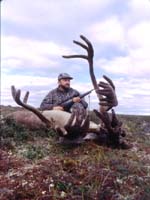 Finally
we saw the caribou's wide, high antlers disappear over a small ridge on
the other side of a narrow pass between two lakes. Although we wanted
to continue to pursue the trophy bull, we gave up the chase instead of
getting wet in the chest-high water.
Finally
we saw the caribou's wide, high antlers disappear over a small ridge on
the other side of a narrow pass between two lakes. Although we wanted
to continue to pursue the trophy bull, we gave up the chase instead of
getting wet in the chest-high water.
But just as we turned to leave, we spotted the big caribou's antlers less than 40 yards from us on the other side of the water. Instinctively Zappia turned and fired. The huge caribou went down. The mile walk around the lake seemed to only take minutes to reach the trophy as adrenaline pumped through each of us. Then we began the arduous task of caping, skinning and quartering Zappia's animal and another taken by another hunter.